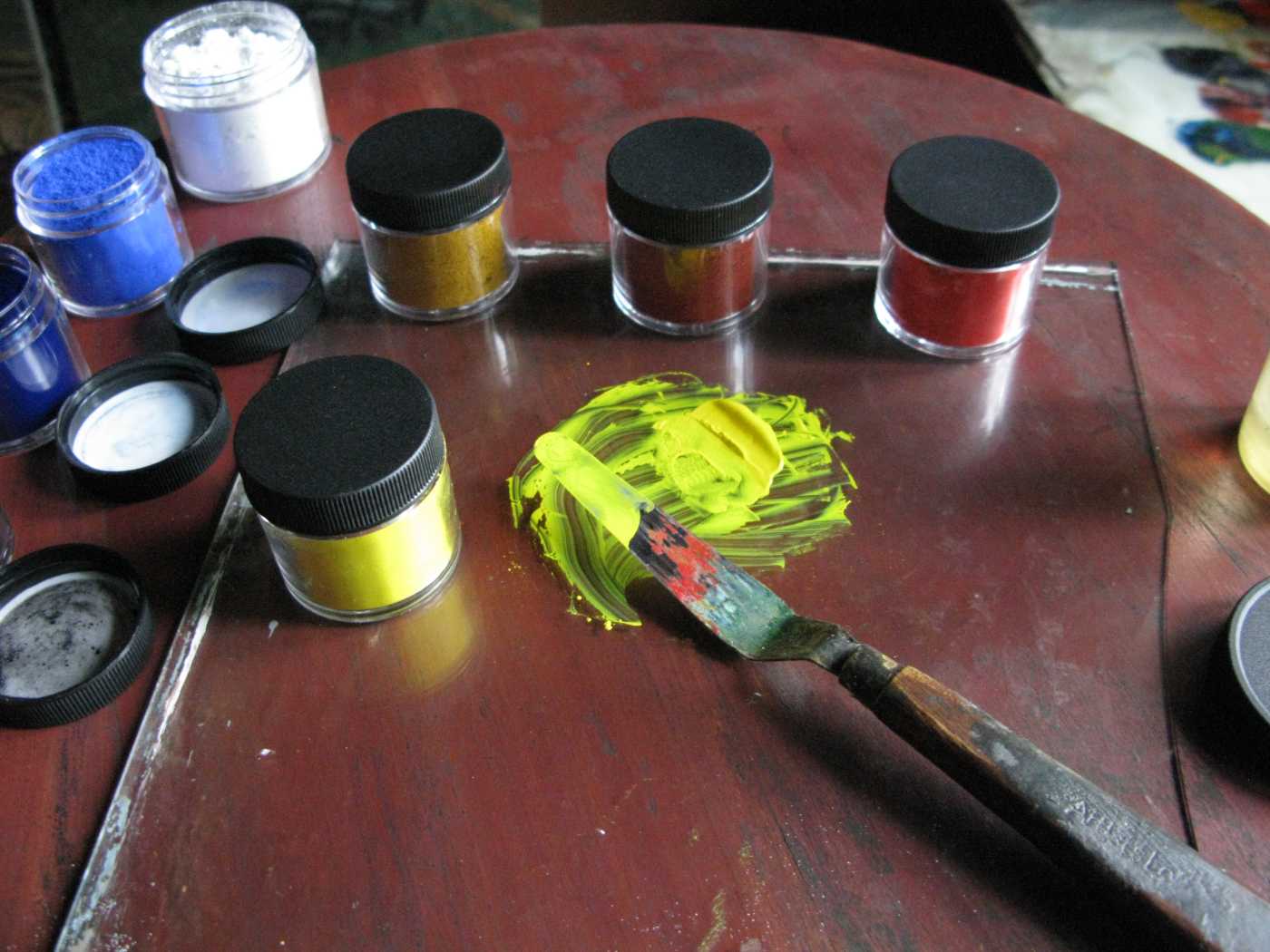
We now offer artist's pigments in an 8-color set. $48.50 per set (all 8 pigments).

This set of 8-dry color-pigments represents an all-around basic and highly-capable palette. Nearly every painting I've created in the past 25-years has been accomplished via these particular pigments; and in other words, the scope of this palette is well-tested and quite comprehensive. There are many pigments available 'out there' but I settled on these in the late 80's. Excepting a possible and faintly occasional need for a clean magenta, these colors allow a perfectly harmonious blend that suits my own eye. Essentially, the duller-colors are used to initiate the overall painting while the brighter colors are brought in frugally at the later stages/layers. Surrounded by dull colors, brighter colors 'sing'.
Not everyone is 'into' making their own oil paints, but doing so can lead to insights not available through use of modern-day 'tube-paint'. Excepting the 60-mil (2-ounce by volume) Zinc white, the various color-pigments are contained within 30-mil (1-ounce by volume) jars, which is more than enough to make the equivalent of a standard 37 mil tube of oil paint --though the idea for using dry pigments is to only make up the paint fresh, as needed; and not all at once. 30 mil. of straight, no filler color-pigment may seem a small amount but when using a traditional layered-approach (as I do, myself), 30 mil. can last for years.
The pigments included in this set are:
Zinc White (60 mil) [Note: I consider this pigment safe, durable, ever-lasting --see my reasons below, at the end of this page.]
Lamp black (30 mil) [Enough pigment to last many, many years of landscapes]
Prussian blue (30 mil) [Enough pigment to last many, many years of landscapes]
Ultramarine blue (30 mil) [enough pigment to easily produce 25+ 16x20 paintings]
Yellow ochre (30 mil) [Enough pigment to produce 25+ 16x20 paintings]
Cadmium Yellow light (30 mil) [Enough pigment to produce 25+ paintings]
Iron Oxide Red/Indian Red (30) [Enough to last many, many years of landscapes]
Cadmium red medium (30 mil) [Enough to last many, many, many years of landscapes]
These 8-pigments are packed in attractive double-wall polystyrene containers. Sold as a set, all 8 pigments are shipped as a single item.
Greens are made by mixing the yellows with the blues on the palette. For example, typical deciduous folliage in a foreground would be composed of the Prussian blue and cadmium yellow, and often with additions of white. Coniferous folliage would be Prussian blue added to yellow ochre. In either case, distant greens would typically call for the use of ultramarine instead of Prussian blue.
Browns are made using lamp black and touches of iron oxide red. This makes an excellent monochrome-brown when applied transparently using various congealing binders/mediums, such as ORIGIN, or any of our three 'gelling varnishes', or Cole's Copal Varnish.
Again, these 8-pigments represent an excellent all-around palette that is fully capable of reproducing portraits or landscapes or marines. The only additional color that would find rare use is a transparent crimson.
It must be underscored that pigments are very fine in particle-size, especially the lamp black and Prussian blue. Open the containers carefully and use only the tip of the palette knife to scoop up a pea-sized amount; then gently tap the knife-tip onto the glass to deposite the dry powder. Wipe the knife before dipping out your binder. No mask should be necessary when using such small amounts of pigment.
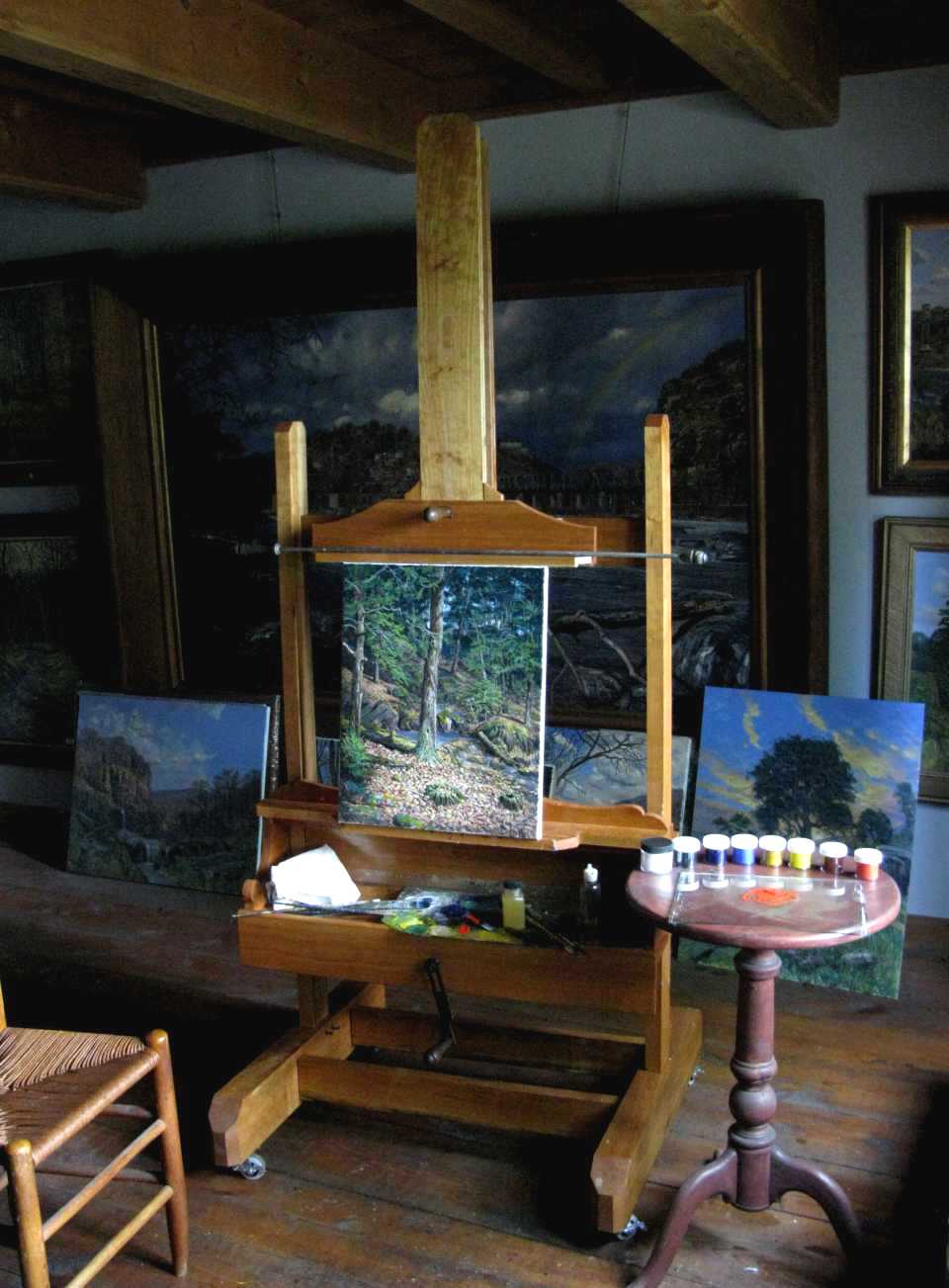
The seemingly illuminated and glowing 16x20-inch painting shown on the large studio easel, "November: The Forest Pool", is typical to the use of ORIGIN Congealed Varnish combined with these 8 color-pigments; the resulting paint was then applied with a solvent technique in a manner resembling egg tempera. More info about ORIGIN click here]
Paint from Pigments
Making your own paint is quite simple. Excepting white, the various colors are made-up in very small amounts and will go a long way through many paintings as would be performed using a traditional manner. All the paint-maker needs is a sheet of scrap glass, a palette knife, and the desired medium or binder. A small pea-sized amount of colored pigment is placed on the glass and a few drops of any binder/ medium is placed beside it. This can be nothing more than some raw traditional fixed oil, such as linseed or walnut oil. The knife is used to roughly mix the two ingredients together, then a swirling and pressing motion quickly disperses the pigment thoroughly and uniformly into a paint. The process takes maybe a minute. Once formed into a paste, the knife is used to scoop-up the fresh paint and transfer it onto the palette. A chosen brush is lightly dipped into solvent (turps usually) then stropped into the paint-edge. This action thins the paint for the desired application. If the painter wishes to avoid solvent-use then the freshly-made paint can be alternatively thinned with nut or other oils.
In the following images walnut oil is being used as the binder, though any preferred medium could be utilized, instead. I particularly recommend using a combination of oil and varnish as the binder for pigments, especially if a solvent will be required as the diluent for the intended paint-application.
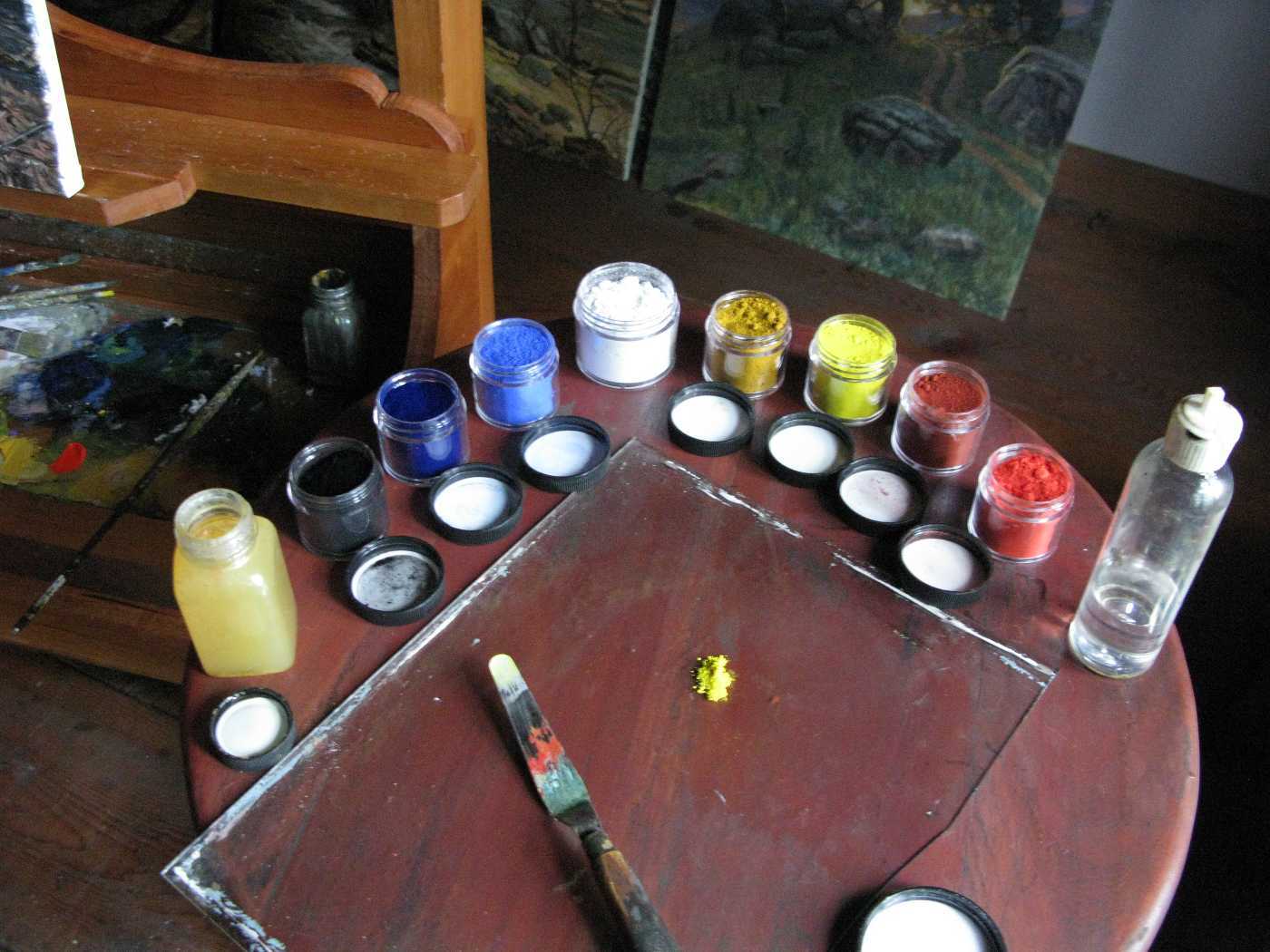
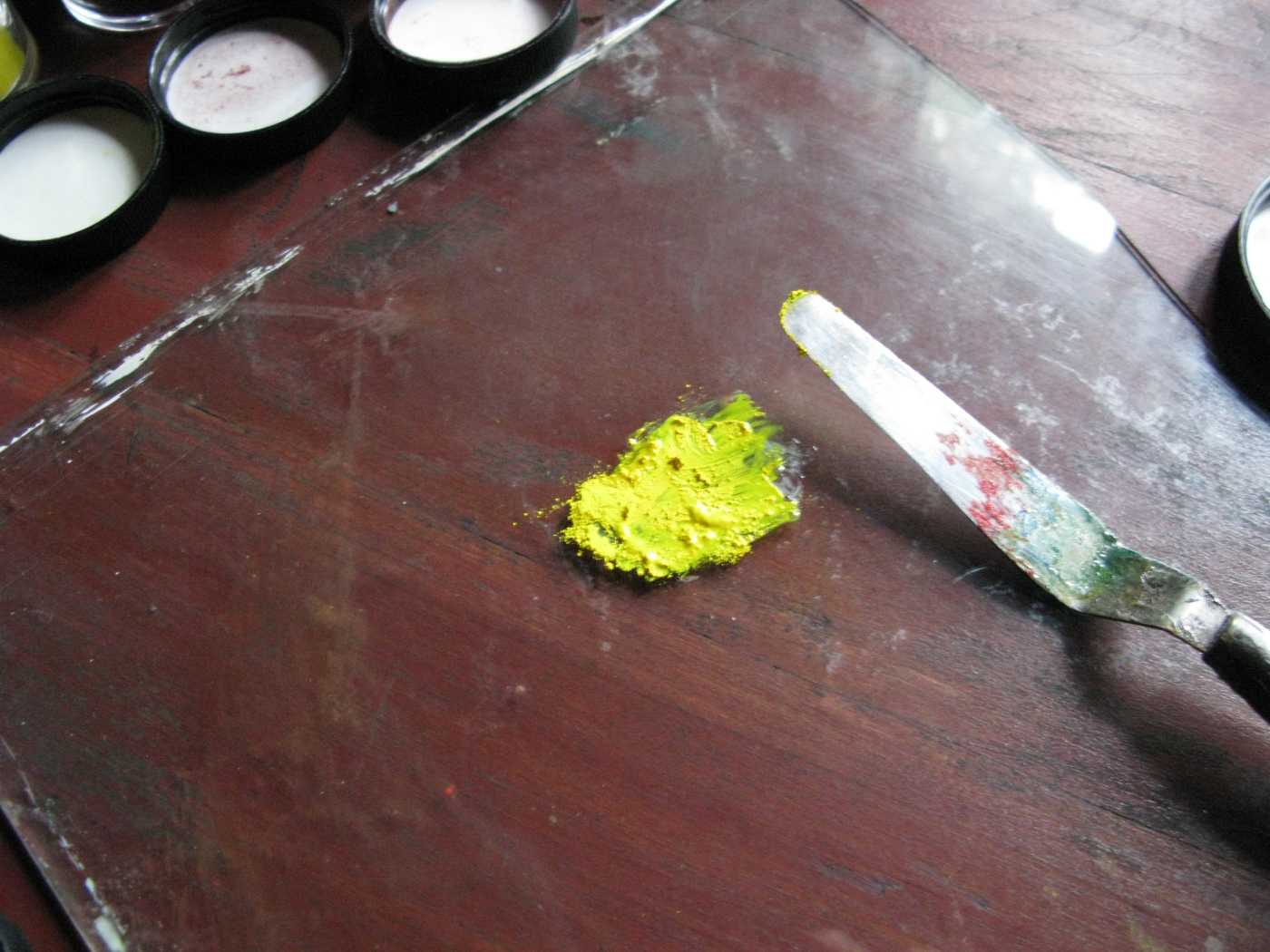
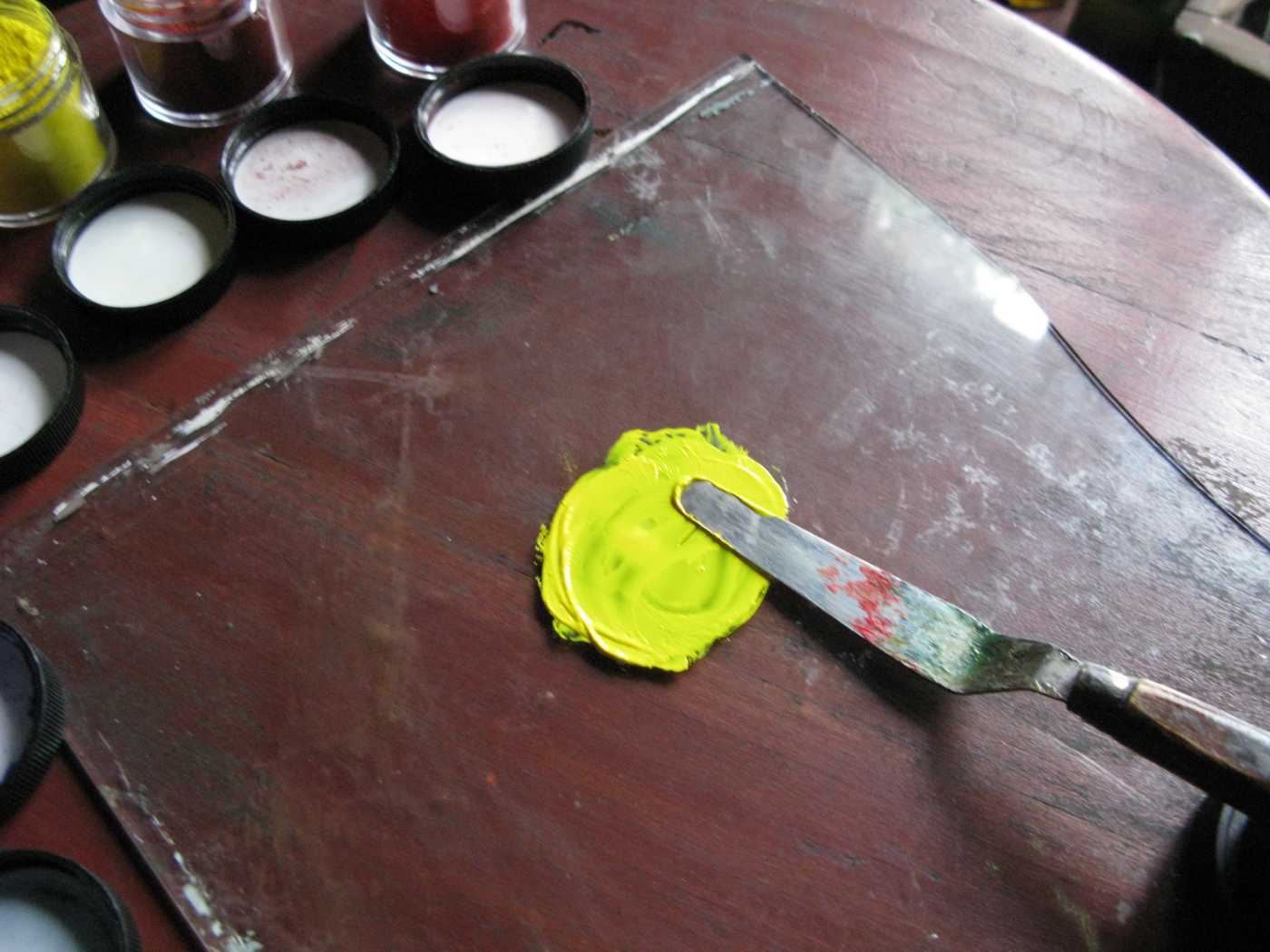
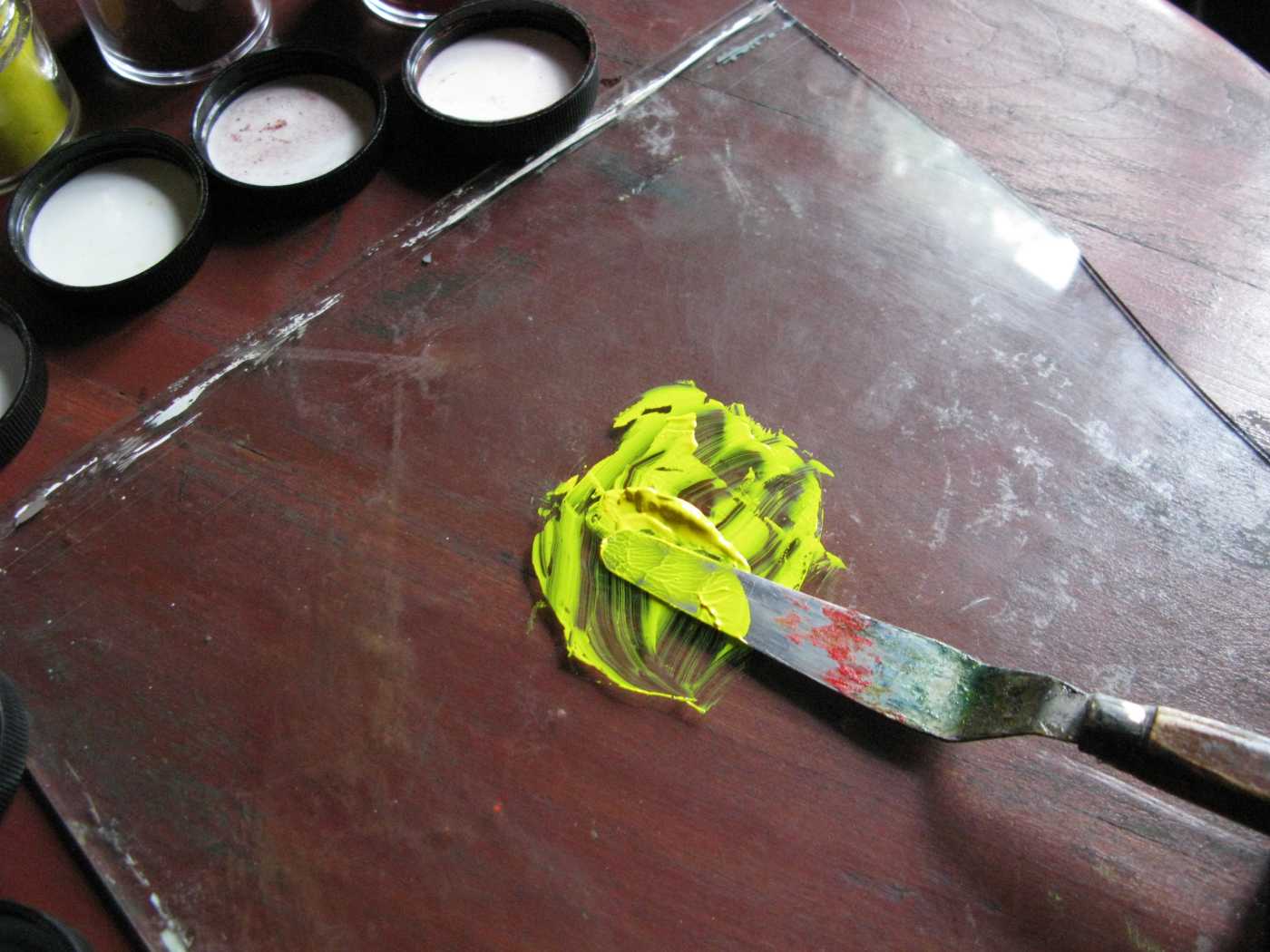
James C. Groves, Frostburg, Maryland, May, 2015
About zinc and its use as a paint:
Yes, I personally support zinc oxide as the best overall white for artists. I trust in its now-long history of safe and durable use.
Be aware my first forays into oil painting involved zinc white and I produced several hundred works using that. I sought out lead carbonate after much research into historical pigments. It was a weaker tint than zinc but I became used to it. By 1993, I had seven 5-gallon buckets of coiled lead sheeting "brewing" at once, to supply my own penchant for this historical pigment.When I entered the internet I found the modern day industrial version equally fine for my purposes. Thus, I have used lead white for many years; and it is a fine paint with positive attributes. That noted, I eventually switched back to using zinc and for several reasons.
One reason is because zinc is in no way a health risk to me, nor anyone around me. I'm one careful individual but I'll admit that I'm getting old and more reckless.
Secondly, zinc oxide creates a whiter appearance than lead carbonate when bound with oils. I want my white to be the very brightest possible.
Third, zinc white will not show yellowing as much as lead carbonate when mixed with painting oils. Yes, it's true-- zinc oxide somehow fights against the oil's inherent yellowing nature--I was rather astounded to discover this amazing attribute as it is not mentioned anywhere, AFAIK.
Fourth: Zinc white becomes harder sooner than lead white -- I value hardness over flexibility. I abhore tack and dust in my own work; and my technique revolves around quickly hardening paint. I don't approve of gummy paint and oil and I'll gladly add resins into my paint to make certain it 'drys' hard.
Fifth: Zinc white is a more intense white than lead white. By this I mean zinc white can be reduced with a solvent or oil to a thinner consistency than lead white without losing its white-appearance; thus it will allow finer and whiter lines to be drawn from it-- and this is a plus in the use of Origin; and especially so, as Origin involves a thin tempera wash-like manner of application.
Sixth: Contrary to the study produced by the National Gallery, Washington DC conservators, I have never experienced any cracking/delamination in my own long use of zinc white, even when bound in simple painting oils (my own very oldest paintings are based on zinc white). Thus, zinc's faster-hardening has never presented any problem for me. Again, I do know zinc white will become harder than lead white and I actually appreciate that characteristic.
Seventh: Both zinc oxide and lead carbonate are alkaline agents and each will generate a 'soap' when bound with the typically acidic painting oils (linseed, walnut, safflower, poppy, etc.). This metal soap migrates and affects other pigments used within the painting, lending durability to less durable paints. However, due to this soap-conversion, lead white may actually fade away through time while zinc will remain its white self.
Eighth: Realize, all oil paints become brittle in time. Zinc white ground in raw oil is merely one paint that becomes harder sooner. Most other oil paints will 'catch up' in due course. This hardness helps zinc white resist atmospheric-attack and degradation much better than a softer paint. Soft paint is flexible but it is also weak to solvency and abrasion.
Additionally, while I much appreciate the value of lead-oil 'soap' migration towards the improved longevity of my paint, this 'soap' is already provided via my chosen pigment-binder. Understand, I gave up the meager practice of using raw oil as my pigment-binder a quarter century ago; instead I use an oil-and-resin-based binder, which has been typically formulated with a lead-oxide.
James C. Groves
For Ordering Online click here
Click here to visit our Gallery page.